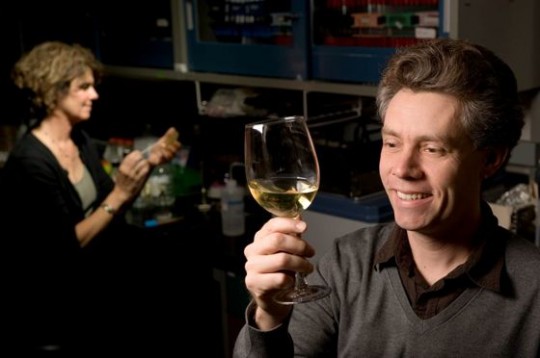Get sloshed, have sex? Wine-making has promoted a frenzy of indiscriminate mating in baker’s yeast, according to Stanford researchers
Get sloshed, have sex? Wine-making has promoted a frenzy of indiscriminate mating in baker’s yeast, according to Stanford researchers

Baker’s yeast, or S. cerevisiae, usually leads a relatively chaste existence – reproduction is accomplished primarily through asexual budding, with an occasional genetic boost from a spontaneous coupling between two of the one-celled organisms. But now Stanford geneticists Gavin Sherlock, PhD, and Barbara Dunn, PhD, have shown that baker’s yeast abandons its monastic lifestyle in wine-maker’s vats. During the past hundreds or thousands of years, it has indulged in a frenzy of indiscriminate mating not just among various strains of its own kind, but also with other entirely different yeast species. The frequency of hook-ups has complicated efforts to parse out yeast’s evolutionary tree, but may have made one of mankind’s favorite indulgences just a little more tasty.
From our release:
The unexpected promiscuity has made the lineage of many commercial and wild yeast strains difficult to trace. But there are also indications that such willy-nilly sharing of genetic information is precisely what gives that hint of passion fruit to your favorite glass of chardonnay, or that round, plummy flavor to your most-recent quaff of zinfandel.
“The strain of yeast used in fermentation definitely affects the flavor of the wine,” said [Sherlock], an associate professor of genetics who personally taste-tested several vintages specially produced by his Gallo collaborators as part of the research, “and we thought that these strains would fall into a nice evolutionary-tree-like structure with a common ancestor.”
Instead they found chaos. The yeast, which normally reproduce asexually, had partnered multiple times not just with one other — mingling strains — but even with members of different species of yeast.
The results were published (subscription required) today in Genome Research. It’s not the first time Sherlock and Dunn have paired up to investigate the effect of yeast strains on alcohol production. In 2008, they published research describing how the present-day lager yeast strain originated from a Bavarian decree to brew beer only during the colder months.
It’s not known yet whether the couplings that occurred in wine vats were accidental or were deliberately orchestrated by eager wine makers from days gone by. But the sloshing around that occurs during fermentation, when the density of yeast is high, could have facilitated the match-ups, according to Sherlock. The researchers are now trying an alternative technique – whole genome sequencing – to nail down exactly who is related to whom, and how, in the extended yeast family. But they’re also investigating what qualities the various yeast strains bring to the table, in the form of flavor, clarity and other characteristics. Of course that will involve a lot more sampling:
“It’s a terrible job, having to taste all that wine,” laughs Sherlock.
By Krista Conger
Stanford University Medical Center
Photo by Steve Fisch
###
* Stanford University Medical Center integrates research, medical education and patient care at its three institutions – Stanford University School of Medicine, Stanford Hospital & Clinics and Lucile Packard Children’s Hospital.
** The above story is adapted from materials provided by Stanford University School of Medicine
________________________________________________________________




















